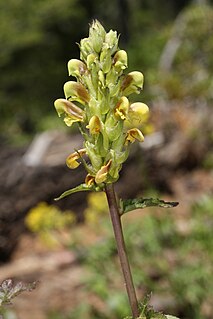
The Lamiaceae
or Labiatae are a family of flowering plants commonly known as the mint or deadnettle family. Many of the plants are aromatic in all parts and include widely used culinary herbs, such as basil, mint, rosemary, sage, savory, marjoram, oregano, hyssop, thyme, lavender, and perilla. Some species are shrubs, trees, or, rarely, vines. Many members of the family are widely cultivated, not only for their aromatic qualities, but also their ease of cultivation, since they are readily propagated by stem cuttings. Besides those grown for their edible leaves, some are grown for decorative foliage, such as Coleus. Others are grown for seed, such as Salvia hispanica (chia), or for their edible tubers, such as Plectranthus edulis, Plectranthus esculentus, Plectranthus rotundifolius, and Stachys affinis.
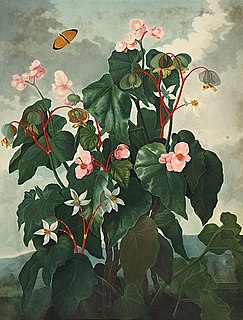
Begonia is a genus of perennial flowering plants in the family Begoniaceae. The genus contains more than 1,800 different plant species. The Begonias are native to moist subtropical and tropical climates. Some species are commonly grown indoors as ornamental houseplants in cooler climates. In cooler climates some species are cultivated outside in summertime for their bright colourful flowers, which have sepals but no petals.
The artichoke is a species of thistle cultivated as a food. Artichoke may also refer to:
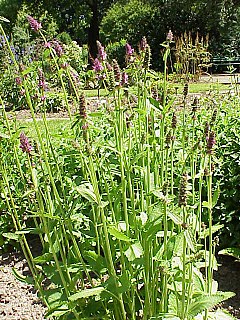
Stachys affinis, commonly called crosne, chinese artichoke, japanese artichoke, knotroot, or artichoke betony, is a perennial herbaceous plant of the family Lamiaceae, originating from China. Its rhizome is a root vegetable that can be eaten raw, pickled, dried or cooked.

The genus Scrophularia of the family Scrophulariaceae comprises about 200 species of herbaceous flowering plants commonly known as figworts. Species of Scrophularia all share square stems, opposite leaves and open two-lipped flowers forming clusters at the end of their stems. The genus is found throughout the Northern Hemisphere, but concentrated in Asia with only a few species in Europe and North America.
Woundwort is the common name for several species of plants and may refer to:
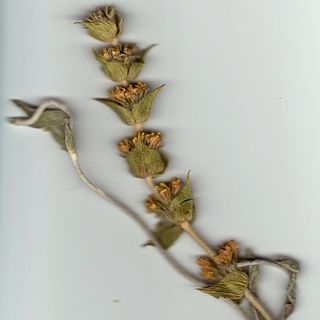
Sideritis, also known as ironwort, mountain tea and shepherd's tea, is a genus of flowering plants well known for their use as herbal medicine, commonly as an herbal tea. They are abundant in Mediterranean regions, the Balkans, the Iberian Peninsula and Macaronesia, but can also be found in Central Europe and temperate Asia.

Bowerchalke Downs, is a 128.6 hectare biological Site of Special Scientific Interest in Wiltshire, notified in 1971. The downs encompass the entire southern outlook of the village of Bowerchalke in the Salisbury district of Wiltshire, England, and are adjacent to both the Hampshire and Dorset county boundaries. The Bowerchalke Downs are located within the Cranborne Chase and West Wiltshire Downs Area of Outstanding Natural Beauty and are part of the Southern England Chalk Formation.

Stachys coccinea, the scarlet hedgenettle or Texas betony, is an ornamental plant of the family Lamiaceae, which is native from Arizona to Texas and from Baja California Sur, Mexico to Nicaragua.
Wood betony is the common name for several plants and may refer to:

Stachys monnieri, alpine betony is a perennial herbaceous flowering plant from the mint family Lamiaceae. Purplish pink colored flowers are produced in dense heads above a thick growth of wrinkled leaves. Plants grow about 18 inches tall when in bloom in mid summer.
S. officinalis may refer to:
The word monnieri (uncapitalized) is a specific epithet for animal and plant species meaning "of Monnier" or "of Le Monnier", and was used to commemorate one of several people having these surnames. Some species with the epithet are:
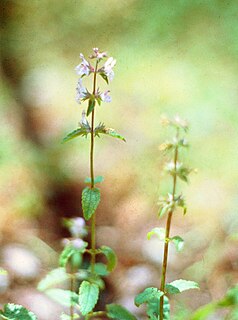
Stachys floridana is a species of betony in the mint family, Lamiaceae. It is native to the United States, where its true native range is probably limited to Florida, but today it is known throughout the Southeast as an introduced species and common weed. It occurs as far west as Texas, and it has been recorded in California. Its common names include Florida betony, Florida hedgenettle, and rattlesnake weed. It has been called wild artichoke, but it is not closely related to artichoke. The plant was the Florida Department of Agriculture's "Weed of the Month" for February 2010.

Stachys hispida, commonly known as hispid hedgenettle, is a species of flowering plant in the mint family (Lamiaceae). It is native to eastern North America, where it is found in Canada and the United States. Its natural habitat is in moist areas, such as alluvial banks, bottomland forests, and wet meadows.

Stachys macrantha, known as big betony, is a species of flowering plant in the mint family, Lamiaceae. It is native to the Caucasus, northeastern Turkey, and northwestern Iran. Growing to 60 cm (24 in) tall by 30 cm (12 in) broad, it is an erect herbaceous perennial with scalloped cordate leaves. Spikes of hooded purplish-pink flowers are borne throughout summer.


